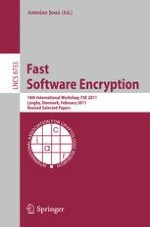This book constitutes the thoroughly refereed post-conference proceedings of the 18th International Workshop on Fast Software Encryption, held in Lyngby, Denmark, in February 2011. The 22 revised full papers presented together with 1 invited lecture were carefully reviewed and selected from 106 initial submissions. The papers are organized in topical sections on differential cryptanalysis, hash functions, security and models, stream ciphers, block ciphers and modes, as well as linear and differential cryptanalysis.
